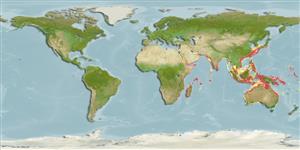>
Gobiiformes (Gobies) >
Gobiidae (Gobies) > Gobiinae
Etymology: Parachaeturichthys: Greek, para = the side of + Greek, chaite = hair + Greek, oura = tail + Greek, ichthys = fish (Ref. 45335).
More on author: Bleeker.
Environment: milieu / climate zone / depth range / distribution range
Ekologi
laut dasar (demersal). Tropical
Indo-West Pacific: south to Natal, South Africa; India (Ref. 4833) and Japan (Ref. 559).
Size / Weight / umur
Maturity: Lm ? range ? - ? cm
Max length : 15.0 cm TL jantan/; (Ref. 2798)
deskripsi pendek
Kunci identifiaksi (pengenalan) | Morfologi | Morfometrik
Duri punggung (Keseluruhan (total)) : 7; duri punggung lunak (Keseluruhan (total)) : 9 - 11; Duri dubur: 1; Sirip dubur lunak: 9 - 10. Body greenish; fins dark; upper caudal fin base with a large black spot surrounded by yellow (Ref. 2798).
Parachaeturichthys spp. Inhabit deep water (Ref. 42915). Rarely enters estuaries (Ref. 4833). Captured by trawls over mud bottom (Ref. 11441). Found to contain tetrodotoxin (TTX) and anhydrotetrodotoxin (anh-TTX) which causes paralytic food poisoning (Ref. 54777).
Life cycle and mating behavior
Kematangan | Reproduksi, perkembang biakan | Pemijahan | telur-telur | Fecundity | Larva
Masuda, H., K. Amaoka, C. Araga, T. Uyeno and T. Yoshino, 1984. The fishes of the Japanese Archipelago. Vol. 1. Tokai University Press, Tokyo, Japan. 437 p. (text). (Ref. 559)
Status IUCN Red List (Ref. 130435: Version 2024-2)
ancaman kepada manusia
Poisonous to eat (Ref. 54777)
penggunaan manusia
Perikanan: tidak ada kepentingan
Alat, peralatan
laporan khas
muat turun XML
Sumber internet
Estimates based on models
Preferred temperature (Ref.
123201): 22.4 - 28.1, mean 26.5 °C (based on 338 cells).
Phylogenetic diversity index (Ref.
82804): PD
50 = 0.7500 [Uniqueness, from 0.5 = low to 2.0 = high].
Bayesian length-weight: a=0.00891 (0.00538 - 0.01477), b=2.92 (2.78 - 3.06), in cm total length, based on LWR estimates for this species & (Sub)family-body (Ref.
93245).
Trophic level (Ref.
69278): 3.1 ±0.3 se; based on diet studies.
Daya lenting (Ref.
120179): Tinggi, Waktu penggandaan populasi minimum kurang dari 15 bulan (Preliminary K or Fecundity.).
Fishing Vulnerability (Ref.
59153): Low vulnerability (10 of 100).
